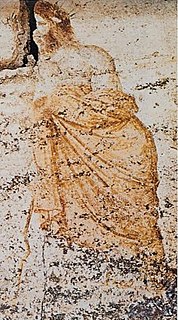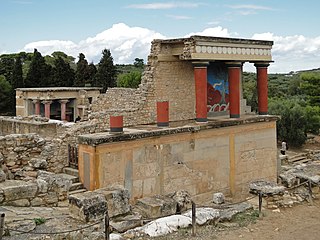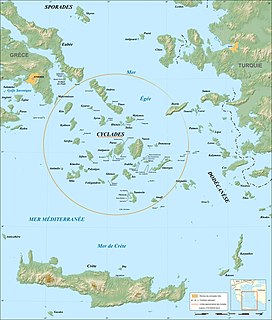Related Research Articles

Crete is the largest and most populous of the Greek islands, the 88th largest island in the world and the fifth largest island in the Mediterranean Sea, after Sicily, Sardinia, Cyprus, and Corsica. Crete rests about 160 km (99 mi) south of the Greek mainland, and about 100 km (62 mi) southwest of Anatolia. Crete has an area of 8,336 km2 (3,219 sq mi) and a coastline of 1,046 km (650 mi). It bounds the southern border of the Aegean Sea, with the Sea of Crete to the north and the Libyan Sea to the south.

Writing is a medium of human communication that involves the representation of a language through a system of physically inscribed, mechanically transferred, or digitally represented symbols.

The 14th century BC is a century that lasted from the year 1400 BC until 1301 BC.
The 1500s BC was a decade lasting from January 1, 1509 BC to December 31, 1500 BC.
Emperor Chōkei was the 98th emperor of Japan, according to the traditional order of succession. He reigned from 1368 through 1383. His personal name was Yutanari (寛成) and his regal name roughly translates to "Long Celebration".

The Minoan civilization was a Bronze Age Aegean civilization on the island of Crete and other Aegean Islands, whose earliest beginnings were from c. 3500 BC, with the complex urban civilization beginning around 2000 BC, and then declining from c. 1450 BC until it ended around 1100 BC, during the early Greek Dark Ages. It represents the first advanced civilization in Europe, leaving behind a number of massive building complexes, sophisticated art, and writing systems. Its economy benefited from a network of trade around much of the Mediterranean.

In Greek mythology, Rhadamanthus or Rhadamanthys was a wise king of Crete. As the son of Zeus and Europa he was considered a demigod. His name means "showing stern and inflexible judgement". He later became one of the judges of the dead and an important figure in Greek mythology.

Knossos is the largest Bronze Age archaeological site on Crete and has been called Europe's oldest city.

John Barbour was a Scottish poet and the first major named literary figure to write in Scots. His principal surviving work is the historical verse romance, The Brus, and his reputation from this poem is such that other long works in Scots which survive from the period are sometimes thought to be by him. He is known to have written a number of other works, but other titles definitely ascribed to his authorship, such as The Stewartis Oryginalle and The Brut (Brutus), are now lost.

The history of Crete goes back to the 7th millennium BC, preceding the ancient Minoan civilization by more than four millennia. The palace-based Minoan civilization was the first civilization in Europe.

The Greek Dark Ages is the period of Greek history from the end of the Mycenaean palatial civilization around 1100 BC to the beginning of the Archaic age around 750 BC.

Cycladic culture was a Bronze Age culture found throughout the islands of the Cyclades in the Aegean Sea. In chronological terms, it is a relative dating system for artifacts which broadly complement Helladic chronology and Minoan chronology (Crete) during the same period of time.

Helladic chronology is a relative dating system used in archaeology and art history. It complements the Minoan chronology scheme devised by Sir Arthur Evans for the categorisation of Bronze Age artefacts from the Minoan civilization within a historical framework. Whereas Minoan chronology is specific to Crete, the cultural and geographical scope of Helladic chronology is mainland Greece during the same timespan (c.3200–c.1050). Similarly, a Cycladic chronology system is used for artifacts found in the Aegean islands. Archaeological evidence has shown that, broadly, civilisation developed concurrently across the whole region and so the three schemes complement each other chronologically. They are grouped together as "Aegean" in terms such as Aegean art and, rather more controversially, Aegean civilization.

Gortyn, Gortys or Gortyna is a municipality, and an archaeological site, on the Mediterranean island of Crete 45 km (28 mi) away from the island's capital, Heraklion. The seat of the municipality is the village Agioi Deka. Gortyn was the Roman capital of Creta et Cyrenaica. The area was first inhabited around 7000 BC.

Minoan religion was the religion of the Bronze Age Minoan civilization of Crete. In the absence of readable texts from most of the period, modern scholars have reconstructed it almost totally on the basis of archaeological evidence of such as Minoan paintings, statuettes, vessels for rituals and seals and rings. Minoan religion is considered to have been closely related to Near Eastern ancient religions, and its central deity is generally agreed to have been a goddess, although a number of deities are now generally thought to have been worshipped. Prominent Minoan sacred symbols include the bull and the horns of consecration, the labrys double-headed axe, and possibly the serpent.
The table of years in architecture is a tabular display of all years in architecture, for overview and quick navigation to any year.
The table of years in music is a tabular display of all years in music, to provide an overview and quick navigation to any year.
The decade of the 1370s in art involved some significant events.
Nationality words link to articles with information on the nation's poetry or literature.
References
- ↑ Castleden, Rodney (1993). Life in Bronze Age Crete. London; New York: Routledge. p. 35.